Introduction to Proteomics
Tools for the New Biology
Samenvatting
Daniel C. Liebler masterfully introduces the science of proteomics by spelling out the basics of how one analyzes proteins and proteomes, and just how these approaches are then employed to investigate their roles in living systems. He explains the key concepts of proteomics, how the analytical instrumentation works, what data mining and other software tools do, and how these tools can be integrated to study proteomes. Also discussed are how protein and peptide separation techniques are applied in proteomics, how mass spectrometry is used to identify proteins, and how data analysis software enables protein identification and the mapping of modifications. In addition, there are proteomic approaches for analyzing differential protein expression, characterizing proteomic diversity, and dissecting protein-protein interactions and networks.
Specificaties
Inhoudsopgave
1 Proteomics and the New Biology
2 The Proteome
II. Tools of Proteomics
3 Overview of Analytical Proteomics
4 Analytical Protein and Peptide Separations
5 Protein Digestion Techniques
6 Mass Spectrometers for Protein and Peptide Analysis
7 Protein Identification by Peptide Mass Fingerprinting
8 Peptide Sequence Analysis by Tandem Mass Spectrometry
9 Protein Identification with Tandem Mass Spectrometry Data
10 SALSA: An Algorithm for Mining Specific Features of Tandem MS Data
III. Applications of Proteomics
11 Mining Proteomes
12 Protein Expression Profiling
13 Identifying Protein-Protein Interactions and Protein Complexes
14 Mapping Protein Modifications
15 New Directions in Proteomics

